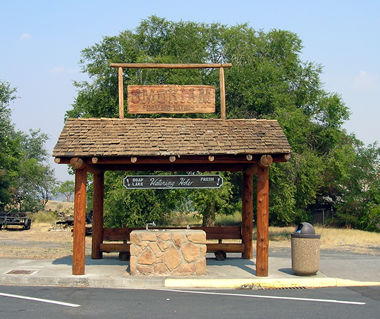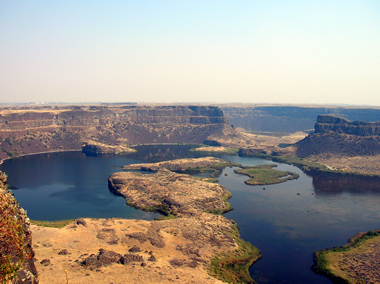|
When it became evident that parts for the warranty work on the RV would not be arriving for at least a week, we decided to get out of Missoula for a while. With diesel costing an average of $3.49/gallon, our goal is to be at our destination on one tank of gas (roughly $100.) We had heard that the Western Horizons resort at Soap Lake was worthy of exploration, so we headed west. Mother Nature seems to have designed the area of Soap Lake especially for rejuvenation. Since Native Americans used the lake's mineral-enriched waters to heal ailments more than a century ago, people have been seeking health and well-being at Soap Lake, one of only two mineral lakes on Earth; the other is in France. Two Indian names for the lake are "Skokiam," meaning "healing waters," and "Let-to-toweints," which means "healing water springs." This indicates that the healing properties of the water was known to the earliest of settlers. Soap Lake is a soft mineral lake because its most abundant mineral, sodium, is a washing soda rather than the calcium salts, which is the main mineral in hard mineral water. Other minerals include bicarbonate, sulfate, carbonate, chloride, and potassium. Another of many unique qualities of the lake is that it is meromitctic, meaning that the water is stratified into layers that do not mix with each other. It is the bottom layer that is most saturated with the healing minerals, a true "Fountain of Youth" formula. Many testimonials attest to curative powers of the water of Soap Lake. Skin, circulatory, digestive, and joint problems seem to be the disorders most commonly benefited by drinking and bathing in the water. In fact, a study is currently taking place to determine the validity of those testimonials.
Watering Hole in Soap Lake, WA Whether or not one believes the stories, there is no doubt that they add to the allure of the area. Our friends, Ann and Tom Caywood, surprised us with a visit while we were at Soap Lake. We've known them for more than a decade, first meeting on the dock at Island Moorings in Port Aransas, Texas. They, too, are boaters/cruisers who've naturally morphed into full-time RVing. It was during their stay that we ventured a mere 10 miles north on SR 17 to Dry Falls. We were absolutely clueless about the history of this area, and as it turned out, we were smack dab in the middle of a geological wonder! While many know that glaciers played a very important part in sculpting this area's landscape, it was most intriguing to learn that long ago (14,000 years) the Great Missoula Floods thundered over the area's basalt cliffs, making it the mightiest waterfall of all time, 400 feet high and 3.5 miles wide! The Dry Falls Interpretive Center was comprised of informative displays and films that described the geology of the area through the ages. We now viewed this entire area through new eyes. Dry Falls Even though Dry Falls is, well, dry, waterfall-lovers have to drive but a short distance to view the spectacular Summer Falls, created by water flowing from Banks Lake. Once the waters plunge 165 feet over a basalt cliff, it makes its way to farmlands where it irrigates thousands of acres of crops in the Basin. Topping off our stay was a visit to Grand Coulee Dam, called by some the eighth wonder of the world. Maybe it's because the Dam dwarfs the Great Pyramids of Egypt, or that it generates more power than a million locomotives, or that it is the largest hydroelectric project in the U.S. Work on the dam began in 1933. In addition to changing the physical landscape of the area by harnessing the second largest river in the U.S. and providing irrigation to the rich farmland of the Columbia Basin, the Grand Coulee Dam was solely responsible for creating towns where nothing but sagebrush, sand and rocks had previously existed. Thousands of people came to the Grand Coulee looking for work in the midst of the Depression. They worked around the clock for nine years to finish the dam project. When it was completed, enough concrete was used to build a sidewalk four feet wide, four inches thick, and 50,000 miles in length; long enough to wrap around the earth twice! We would have liked to stay longer, knowing full well that we had only scratched the surface of all there is to see in this area. Although we are not planners by nature, we have already penciled in North Central Washington State for Summer, 2007. |
|


